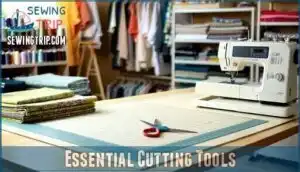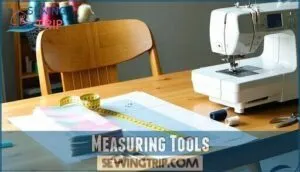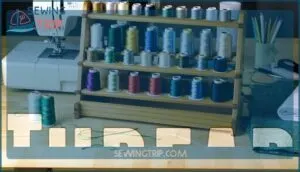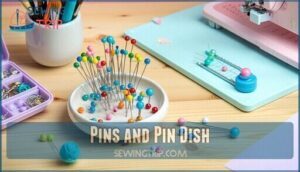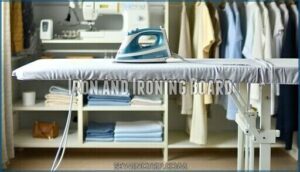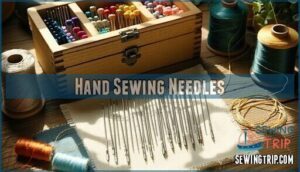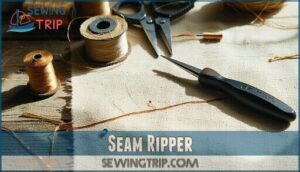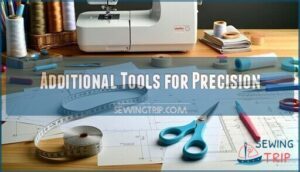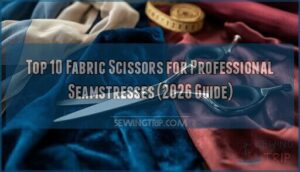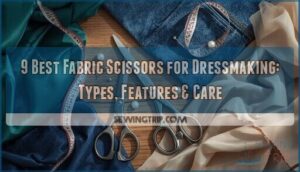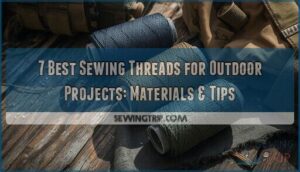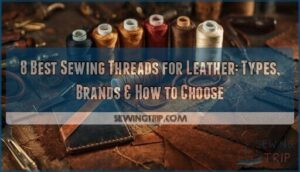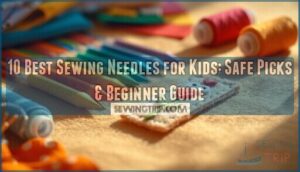This site is supported by our readers. We may earn a commission, at no cost to you, if you purchase through links.
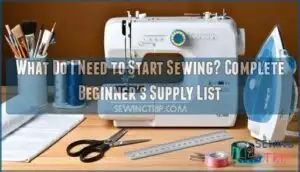 You’ll need a sewing machine as your workhorse, sharp fabric scissors for clean cuts, measuring tools like rulers and tape measures, thread in basic colors, pins to hold pieces together, and an iron for pressing seams.
You’ll need a sewing machine as your workhorse, sharp fabric scissors for clean cuts, measuring tools like rulers and tape measures, thread in basic colors, pins to hold pieces together, and an iron for pressing seams.
Don’t forget hand-sewing needles for detail work and a seam ripper for fixing mistakes. Start with these essentials rather than buying everything at once – quality basics beat quantity every time.
A cutting mat protects your surfaces, while fabric marking tools help you stay on track. These fundamentals will handle most beginner projects without breaking the bank.
Smart tool choices can transform your sewing experience from frustrating fumbles into smooth, professional-looking results.
Table Of Contents
Key Takeaways
- Start with quality basics over quantity – You’ll get better results investing in reliable fabric scissors, measuring tape, pins, thread, and an iron rather than buying every tool at once
- Choose a beginner-friendly sewing machine – Focus on models with adjustable stitches, proper tension control, and smooth speed options from trusted brands rather than machines packed with fancy features you won’t use
- Stock essential cutting tools for precision – You’ll need sharp fabric shears (7-10 inches), a self-healing cutting mat, and dedicated paper scissors to protect your fabric shears from dulling
- Keep error-correction tools within reach – A quality seam ripper and hand-sewing needles are essential since mistakes happen to everyone, and these tools make fixes quick and painless
Sewing Machine
When choosing your first sewing machine, prioritize basic reliability over fancy features.
Look for adjustable stitch types, proper tension control, and smooth sewing speed options.
Essential sewing machine needles and presser feet should come included.
Focus on bobbins management systems that’re easy to load.
Regular machine maintenance keeps everything running smoothly.
Start with beginner-friendly models from trusted brands – they’ll handle cotton fabrics beautifully while you master the fundamentals of stitching.
Essential Cutting Tools
You’ll need sharp, reliable cutting tools to transform fabric into your sewing projects with precision and ease.
Quality scissors and a proper cutting surface make the difference between clean, professional edges and frustrating frayed messes, which can be influenced by the use of reliable cutting tools.
Scissors
Quality fabric shears are your cutting lifeline. High-quality sewing scissors designed specifically for fabric deliver clean, precise cuts that cheap alternatives can’t match.
Stainless steel blades stay sharper three times longer than general-purpose scissors. Choose 7-10 inch fabric cutting scissors from trusted brands.
Never use them on paper—it dulls blades instantly. Regular blade sharpening and proper storage prevent nicks.
Dedicated cutting tools separate amateur work from professional results. Investing in good sewing scissors requires understanding of proper scissor maintenance techniques.
Cutting Board
Transform your workspace with a reliable cutting mat that’ll revolutionize your fabric preparation.
Self-healing cutting mats protect surfaces while extending rotary cutter blade life by forty percent. These precision cutting surfaces feature gridlines for accurate measurements and angles.
Choose cutting mats sized for your space – eighteen by twenty-four inches works for most projects, while quilters need larger options.
Quality rotary tools paired with proper cutting surfaces guarantee clean, professional results every time. For peak performance, consider a high-quality cutting mat product to enhance your sewing experience.
Extra Sewing Machine Needles
Machine needles wear out faster than you’d think.
Stock different needle types in your sewing machine toolkit – universal needles work for most woven fabrics, while ballpoint needles handle knits without creating runs.
Needle sizes range from 60/8 for delicate fabrics to 110/18 for heavy materials.
Replace needles every 6-8 hours of sewing time to maintain ideal thread compatibility and prevent fabric damage.
Understanding proper needle selection techniques is essential for achieving professional results.
- Universal needles (80/12) – perfect starting point for cotton and basic woven fabrics
- Ballpoint needles (70/10-90/14) – slide between knit fibers instead of piercing them
- Heavy-duty needles (100/16-110/18) – power through denim, canvas, and multiple fabric layers
- Sharp needles (60/8-80/12) – create clean holes in tightly woven fabrics like silk and microfibers
Fabric Marking Tools
When you’re ready to transfer pattern markings onto fabric, marking tools become your silent partners in precision. These tools bridge the gap between paper patterns and successful finished projects.
| Tool Type | Best For | Removal Method |
|---|---|---|
| Water-soluble fabric pens | Detailed markings, light fabrics | Disappears with water/washing |
| Air-soluble markers | Quick temporary marks | Fades naturally in 24-48 hours |
| Marking chalk/tailor chalk | Dark fabrics, quick marks | Brushes away easily |
| Tracing wheels with paper | Professional pattern transfer | Washes out after laundering |
Start with water-soluble fabric markers for most projects. They’ll vanish completely when you wash your finished piece. Air-soluble markers work great for temporary marks that fade on their own. Marking chalk remains the go-to choice for dark fabrics where pens won’t show up clearly.
Always test any fabric marker on scraps first. You’ll want to confirm the marks actually disappear before marking your main fabric. A tracing wheel paired with dressmaker’s carbon creates precise pattern transfers for complex designs.
Measuring Tools
Accurate measurements make the difference between a garment that fits beautifully and one that hangs awkwardly. Your measuring toolkit doesn’t need to be extensive, but each tool serves a specific purpose.
Tape Measures are your go-to tool for body measurements and curved areas. Choose a flexible 60-inch tape measure that won’t stretch over time. Fiberglass versions resist warping better than plastic alternatives.
Transparent Rulers work perfectly for straight cuts and seam allowances. A 6" x 24" clear acrylic ruler shows fabric underneath while providing accurate measurements.
Seam Gauges are small metal rulers with adjustable markers that excel at measuring consistent hem depths and seam allowances. They’re incredibly handy for marking ¼" and ½" measurements repeatedly.
Yardsticks handle longer measurements like drape lengths and fabric yardage. Metal versions stay straight longer than wooden ones. Adjustable Rulers fold out for extended measurements but store compactly in your sewing box.
Remember to check your tape measure’s accuracy periodically against a standard ruler. Stretched tapes can throw off your entire project’s fit.
Thread
Thread selection makes or breaks your sewing projects.
Polyester thread works for most fabrics, while cotton threads suit natural fibers better.
Thread weight matters—lighter weights for delicate fabrics, heavier for denim.
Synthetic threads like polyester resist fading and stretching.
Cotton threads breathe with natural fabrics but may shrink.
Color selection should match your fabric or go one shade darker.
Stock basic neutrals: white, black, navy, and beige.
Quality sewing threads prevent breaking and tangling issues that plague cheap alternatives.
Pins and Pin Dish
Once your thread is sorted, it’s time to wrangle those tiny, sneaky sewing pins. Keeping pins under control is half the battle, and a magnetic pin dish is your best ally.
As well as corralling stray straight pins, but it also doubles as a catch-all for dropped needles and snaps. For pin storage, try:
- Magnetic pin cushions for easy pickup and fewer accidents
- Weighted ceramic pin dishes that stay put on busy tables
- Wall-mounted magnetic bars for a sleek, modern look.
Choose sturdy sewing pins with colorful heads—think glass or ball head pins. Pair them with a thimble for safe, smooth pinning every time, using colorful heads for better visibility.
Iron and Ironing Board
Your pressing tools transform flat fabric into professional-looking garments.
An iron with adjustable heat control and steam settings handles various fabric weights, while a sturdy ironing board provides the stable surface you need.
Regular soleplate cleaning prevents fabric damage and maintains smooth gliding.
When choosing an ironing board, consider the benefits of an extra wide ironing board for larger projects.
| Component | Key Feature |
|---|---|
| Iron | Steam settings and heat control |
| Board | Adjustable height and sturdy construction |
| Covers | Heat-resistant and replaceable padding |
Proper iron maintenance extends tool life and prevents scorching.
Clean your soleplate regularly and empty water reservoirs after use to avoid mineral buildup, ensuring smooth gliding and preventing fabric damage with adjustable heat control and steam settings.
Hand Sewing Needles
Hand sewing needles remain indispensable sewing tools, even in our machine-dominated era.
These slender allies handle delicate tasks your machine can’t master. Smart needle selection involves matching needle sizes to fabric weight and choosing appropriate needle materials for durability.
Essential needle types include:
- Sharps – Universal needles for general hand stitches
- Embroidery needles – Larger eyes accommodate decorative thread types
- Betweens – Short needles perfect for precise quilting sewing techniques
Store needles in magnetic holders or needle books to prevent loss and maintain sharp points for clean fabric penetration.
Seam Ripper
Nobody wants to spend hours unpicking stitches, but mistakes happen to everyone. A seam ripper tool becomes your lifeline for error correction and fabric repair.
Mistakes are inevitable, but your seam ripper makes fixing them quick and painless.
This sharp-pointed instrument makes stitch removal painless when you’ve sewn something backward or caught extra fabric layers. Choose a seam ripper with a comfortable grip and sharp blade.
The pointed end slides under individual stitches while the curved blade cuts threads cleanly. Work slowly to avoid tearing fabric – patience saves you from creating bigger problems.
Replace dull seam rippers immediately since they can damage fabric during thread removal. A quality tool lasts through countless projects and becomes indispensable for professional-looking results.
Keep it within arm’s reach because even experienced sewers need seam removal occasionally. Consider buying two – one for your main workspace and another for portable sewing kits. To achieve perfect stitch removal, understanding seam ripper techniques is essential for any sewing project.
Additional Tools for Precision
While basic tools get you started, a flexible tape measure guarantees accurate body measurements and curved edges.
Paper scissors keep your fabric shears sharp by handling patterns and paper templates separately.
Flexible Tape Measure
Beyond measuring fabric lengths, your flexible tape measure becomes essential for accurate body measurements and curve measurement techniques. Most sewing tape measures span 60 inches, accommodating thorough body fitting requirements while maintaining precision through their fiberglass construction that resists stretching over time.
- Wrap snugly around bust, waist, and hips for accurate sizing measurements
- Measure shoulder-to-hem length for proper garment proportions and fit
- Use dual-sided markings (inches/centimeters) for versatile measuring techniques
- Store properly to prevent kinking and maintain measuring tools accuracy
Understanding the basics of sewing tape measures is vital for achieving precise fits and professional finishes in sewing projects, which requires a good understanding of sewing tape measures.
Paper Scissors
Protecting your fabric scissors means keeping separate paper scissors for pattern work.
These specialized scissors feature smaller, pointed tips perfect for detailed cutting around pattern pieces.
Unlike fabric shears, paper scissors handle the dulling effects of cutting through pattern tissue without compromising your main cutting tools’ sharpness—extending their lifespan substantially, which is crucial for maintaining the quality of your fabric shears and ensuring they remain effective for detailed cutting.
Tracing Tools (Optional)
Pattern transfer becomes effortless with the right marking tools.
Tracing wheels paired with dressmaker paper create precise markings on fabric, while chalk and fabric pens offer temporary guidance for construction lines.
Here are three essential tracing tools:
- Tracing wheels and dressmaker paper – Transfer pattern details accurately onto fabric without permanent marks
- Heat-erasable pens – Provide clean lines that disappear with iron heat, streamlining your workflow
- Chaco liners – Dispense fine chalk powder for highly visible markings that brush away easily.
These tools aren’t mandatory for beginners, but they facilitate professional-level precision in pattern work.
Frequently Asked Questions (FAQs)
What should you have in a beginner’s sewing kit?
Your beginner’s toolkit needs fabric scissors, measuring tape, pins, hand needles, thread, seam ripper, and iron. These foundation pieces release your creative potential without overwhelming your workspace or budget initially.
Do you need a sewing machine for beginners?
You don’t need a sewing machine to start, but it’ll speed things up dramatically. Hand-sewing works for small projects, repairs, and learning basics, though it’s time-consuming for larger garments.
What do you need for a beginner sewing space?
Unlike a cramped corner, your sewing space needs room to breathe.
Essential items include a sturdy table, good lighting, storage for supplies, cutting mat, iron, and organized thread storage for efficient workflow.
What equipment do you need to learn to sew?
You’ll need fabric scissors, measuring tape, pins, thread, needles, seam ripper, and an iron. Start with cotton fabric—it’s forgiving and easy to handle for learning basic techniques.
Do you need a sewing kit?
A dedicated sewing kit isn’t essential, but it’s convenient. You’ll gather scissors, pins, thread, needles, seam ripper, measuring tape, and marking tools anyway. Kits offer basics in one package.
Where can I buy beginner sewing supplies?
Local craft stores like Joann’s, Michaels, and Hobby Lobby offer everything you’ll need.
Online retailers including Amazon and mood fabrics provide convenience.
Start with basics: thread, needles, scissors, and beginner-friendly cotton fabric.
What does a beginner need for sewing?
You’ll need fabric scissors, measuring tape, pins, thread, hand and machine needles, seam ripper, and an iron. Start with cotton fabric—it’s forgiving and easy to handle for beginners.
Can I learn sewing on my own?
You can teach yourself sewing through online tutorials, books, and practice. Start with simple projects like pillowcases or tote bags to build confidence and skills gradually.
What accessories do I need for a sewing machine?
You’ll need bobbins, various needles for different fabrics, quality thread in common colors, sharp fabric scissors, seam ripper, pins, measuring tape, and an iron for pressing seams.
What is the easiest thing to sew for a beginner?
Simple pillowcases or tote bags are perfect starter projects.
They use straight seams, forgiving cotton fabric, and basic techniques.
You’ll practice essential skills like cutting, pinning, and seaming without complex curves or zippers to frustrate you.
Conclusion
Looking at what do I need to start sewing feels like staring at Odysseus’ vast ocean journey – overwhelming at first glance.
However, your sewing adventure begins with just these essential tools in your creative arsenal. You don’t need every gadget immediately; focus on quality basics that’ll grow with your skills.
Start with the fundamentals outlined above, then expand your collection as projects demand specific tools.
Remember, even master seamstresses began with simple supplies and determination to create something beautiful.
- https://www.tillyandthebuttons.com/2019/01/how-to-start-sewing.html
- https://weallsew.com/basic-sewing-tools-for-beginners/
- https://www.blog.wawak.com/post/essential-sewing-supplies-for-beginners
- https://babylock.com/top-14-sewing-tools-all-beginners-need
- https://thequiltshow.com/quiltipedia/what-are-basic-sewing-supplies

